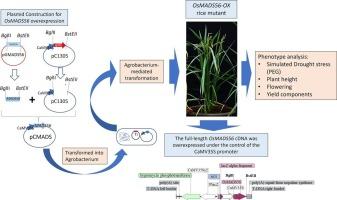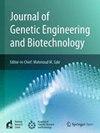Phenotyping analysis of rice cv. Nipponbare overexpressing OsMADS56 gene in drought tolerance, plant height, and yield components
IF 2.8
Q3 Biochemistry, Genetics and Molecular Biology
Journal of Genetic Engineering and Biotechnology
Pub Date : 2025-09-11
DOI:10.1016/j.jgeb.2025.100570
引用次数: 0
Abstract
Background
The MADS-box protein family is a transcription factor (TF) family whose members harbour a MADS-box domain located in their N-terminal. This domain consists of 60 amino acids and functions in DNA binding. In plants, these family genes broadly regulate plant growth, development and responses to various environmental stresses. In this study, an OsMADS56 (702 bp) was isolated from rice (Oryza sativa cv. Nipponbare) to investigate its role in response to drought stress and other agronomic phenotypes at both the vegetative and generative stages.
Results
Rice mutants harbouring overexpressed OsMADS56 gene driven by the constitutive 35S promoter were generated. Quantitative real-time (qRT)-PCR confirmed the overexpression of OsMADS56 at T1 (M76.7) generation. Observation of the T2 OsMADS56-overexpressed rice line (OX7) showed improved tolerance to drought stress. It also showed different agronomic phenotypes compared to wild type (WT), such as shorter plant height (PH) and improved productivity as indicated by earlier heading date (HD), a higher number of panicles (NP), a higher number of grains (NG) and higher grain yield (GY) than WT.
Conclusion
The findings suggest that OsMADS56 was implicated in the rice response to PEG-induced drought stress, rice plant height, and yield components. The OsMADS56 gene and the characterized line can be utilized in further studies on rice adaptation against abiotic stress and its productivity.

水稻变异基因表型分析。OsMADS56基因在耐旱性、株高和产量成分中的过表达
MADS-box蛋白家族是一个转录因子(TF)家族,其成员在其n端含有MADS-box结构域。该结构域由60个氨基酸组成,在DNA结合中起作用。在植物中,这些家族基因广泛调控植物的生长、发育和对各种环境胁迫的反应。本研究从水稻(Oryza sativa cv.)中分离到OsMADS56基因(702 bp)。Nipponbare)研究其在营养和生殖阶段对干旱胁迫和其他农艺表型的响应中的作用。结果在组成型35S启动子驱动下获得了OsMADS56基因过表达的水稻突变体。qRT -PCR证实OsMADS56在T1 (M76.7)代过表达。T2 osmads56过表达水稻品系(OX7)对干旱胁迫的耐受性提高。与野生型(WT)相比,OsMADS56表现出不同的农学表型,如较短的株高(PH)、较早的抽穗期(HD)、较高的穗数(NP)、较高的粒数(NG)和较高的产量(GY)。结论OsMADS56参与了水稻对peg诱导的干旱胁迫、水稻株高和产量的响应。OsMADS56基因及其鉴定品系可用于水稻对非生物胁迫的适应性及其产量的进一步研究。
本文章由计算机程序翻译,如有差异,请以英文原文为准。
求助全文
约1分钟内获得全文
求助全文
来源期刊

Journal of Genetic Engineering and Biotechnology
Biochemistry, Genetics and Molecular Biology-Biotechnology
CiteScore
5.70
自引率
5.70%
发文量
159
审稿时长
16 weeks
期刊介绍:
Journal of genetic engineering and biotechnology is devoted to rapid publication of full-length research papers that leads to significant contribution in advancing knowledge in genetic engineering and biotechnology and provide novel perspectives in this research area. JGEB includes all major themes related to genetic engineering and recombinant DNA. The area of interest of JGEB includes but not restricted to: •Plant genetics •Animal genetics •Bacterial enzymes •Agricultural Biotechnology, •Biochemistry, •Biophysics, •Bioinformatics, •Environmental Biotechnology, •Industrial Biotechnology, •Microbial biotechnology, •Medical Biotechnology, •Bioenergy, Biosafety, •Biosecurity, •Bioethics, •GMOS, •Genomic, •Proteomic JGEB accepts
 求助内容:
求助内容: 应助结果提醒方式:
应助结果提醒方式:


